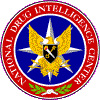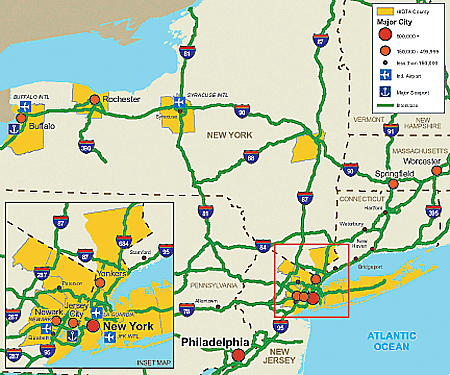
|
National
Drug Intelligence Center New York/New Jersey High Intensity Drug Trafficking Area Drug Market Analysis June 2007 ProductionIllicit drug production is limited in the HIDTA region; however, some production of marijuana does occur, particularly in the Upstate New York counties. In addition, heroin is often repackaged into retail quantities in the New York metropolitan area, and powder cocaine is commonly converted to crack in the HIDTA region. African American, Dominican, and Jamaican distributors are the primary groups involved with converting powder cocaine to crack; it is often converted in small batches near the intended market because federal sentences for distribution or possession of crack are lengthier than those for powder cocaine. Some crack is transported from New York City to New Jersey. Of the crack sold in the HIDTA's Upstate New York counties, about half is converted from powder at the market site and half is transported from New York City as crack. Most of the marijuana available in the HIDTA region is transported from the Southwest Border area and, to a lesser extent, Canada; however, some is produced locally. Large outdoor cannabis grow sites are uncommon, even in the rural areas of the HIDTA region's Upstate New York counties; however, residences throughout the HIDTA region are being used by marijuana producers to house indoor hydroponic operations. The number of these operations is increasing in the HIDTA region, particularly on Long Island. Dominican groups and Caucasian criminal organizations control hydroponic grow operations in Bayside and Nassau County. Low-level members of IOC families are also involved in producing hydroponic marijuana on Long Island. These groups are attracted to marijuana production because of the drug's tremendous profit margin and because penalties for possession and distribution are lower than those for many other drugs. In the past, grow operations were usually small, unsophisticated undertakings that produced limited quantities for personal use but now are typically larger and more sophisticated operations11 that are designed to yield substantial quantities of high-potency marijuana for distribution. Heroin is sometimes milled in the New York metropolitan area of the HIDTA region. Several heroin mills have been seized over the past few years. Recently, Drug Enforcement Administration (DEA) agents seized a heroin mill/stash house located in a residence in Westchester County. Agents seized 60,000 glassine bags (approximately 22 kg) of heroin, which had been concealed in traps in the stash house's floor, as well as cutting and packaging materials. All the recently seized mills were large operations hidden in homes located in residential areas. Heroin mills represent a potential vulnerability for heroin organizations because personnel with knowledge of trafficking operations are often at these sites, along with substantive evidence (ledgers, phone records, etc.) and substantial quantities of heroin. In 2005 SA heroin purity in the area declined, continuing a downward trend first noted in 2003. Purity in both New York City (49.4%) and Newark (48.0%) fell behind that of Philadelphia (54.9%). During that time Philadelphia, New York City, and Newark ranked first, second, and third, respectively, in SA heroin purity.12 This was the first time in several years that Newark did not lead the nation in SA heroin purity. Methamphetamine production is very low in the NY/NJ HIDTA region but may be increasing. The metropolitan nature of the New York City area makes the concealment of laboratories there very difficult; however, several have been seized over the past year in Brooklyn, the Bronx, Long Island, Manhattan, Queens, and Westchester County. These laboratories, like most of those seized in the rural areas of the HIDTA region, were small--only personal use quantities could be produced in them. Most of the methamphetamine available in the region is produced in Mexico or on the West Coast and then transported to the HIDTA region for distribution.
TransportationThe HIDTA region's expansive transportation infrastructure is exploited by DTOs to transport drugs into and throughout the region. Six major interstate highways and 10 subsidiary interstates offer extensive transportation options from the New York metropolitan area to population centers throughout the country. Interstate 95 alone connects the HIDTA region directly to cities and towns along the East Coast, where over a quarter of the U.S. population resides; I-95 also connects the region to 10 major airports and 10 major seaports. Three international airports--John F. Kennedy, Newark Liberty, and LaGuardia--make the New York metropolitan area one of the world's busiest air transportation hubs, and various other international airports, including Buffalo Niagara International Airport and Albany International Airport, serve the region. Amtrak passenger rail service, commuter rail services, the largest subway system in the world, and an extensive network of commercial buses and taxis provide traffickers with additional transportation options to and within the area. The Port of New York/New Jersey is the largest container port complex on the East Coast of North America. Cargo is shipped to the port from more than 150 countries, and in 2006 the port handled more international cargo than ever before, over $149 billion worth (see Figure 2). Erie County in Upstate New York provides access to four major land POEs on the U.S.-Canada border.13 DTOs routinely take advantage of these numerous transportation options to smuggle drugs into and throughout the HIDTA region. Law enforcement officials also report that DTOs are increasingly using indirect routes such as state routes and back roads to transport drugs to the HIDTA region in an attempt to avoid law enforcement interdiction.
A wide variety of DTOs smuggle illicit drugs into the HIDTA region, using virtually every conceivable method. Colombian, Dominican, and Mexican DTOs are the major transporters of illicit drugs; Mexicans DTOs are taking on a more substantial role. Colombian, Dominican, and Mexican DTOs, sometimes contracting with each other, transport drugs overland from the Southwest. They also contract with Caribbean transportation groups to smuggle drugs from South America to Florida on maritime conveyances and onward to the HIDTA region by private and commercial vehicles and commercial aircraft. Colombian and Dominican DTOs arrange to have drugs shipped into the HIDTA's major airports, primarily by couriers on commercial aircraft, and into the Port of New York/New Jersey, chiefly in containerized cargo. However, as Mexican organizations increase their activity, more drug shipments are being transported to the region overland, mostly from areas at or near the Southwest Border, and fewer are being shipped from Florida. In addition, Mexican DTOs based in Atlanta, Georgia, are shipping increasing quantities of drugs from Atlanta to the NY/NJ HIDTA region. Mexican DTOs also are responsible for the influx of higher-purity crystal methamphetamine that is being transported to the area. In March 2007 the DEA seized 75 pounds of crystal methamphetamine in Newark, the largest crystal methamphetamine seizure in the state. The drugs had been transported overland from the Southwest Border area by members of a Mexican DTO and were to be distributed throughout the HIDTA and other areas in the Northeast. Venezuela increasingly is being used as a transshipment area for cocaine and heroin transported by Colombian DTOs to the HIDTA region. Law enforcement pressure exerted in Colombia has caused some paramilitary groups involved in the drug trade to move their base of operations from Colombia to Venezuela. While some coca and opium poppy are grown in Venezuela, the country is mostly used as an operations base in which the final product is processed and shipped to drug markets in the United States. DTOs transport cocaine and heroin on commercial airlines from Venezuela, through other countries such as Ecuador and Mexico, to airports in the HIDTA region. These drugs are also transported to other areas of the United States, such as Texas, and transported overland to the HIDTA. To lower the risk of having large quantities of drugs seized, many Colombian and Dominican DTOs store drugs in suburban areas outside New York City and bring smaller amounts into the city that they can distribute quickly. These stash locations are usually residences in suburban neighborhoods. Colombian DTOs are using such stash locations in the suburbs of Long Island and Westchester County and in areas with large Colombian populations, including Hudson and Passaic Counties in northern New Jersey. Many Dominican DTOs are also using stash locations in suburban neighborhoods in northern New Jersey. Once shipments of cocaine and heroin arrive in the New York City metropolitan area, portions of the shipment are sometimes transported to the Upstate New York counties of the HIDTA region. Most of the cocaine and heroin abused in upstate markets is transported by couriers, often female, and upstate dealers who travel to New York City from Albany, Buffalo, Rochester, and Syracuse to bring back midlevel to wholesale quantities of the drugs for distribution. As upstate markets have increased in size, larger quantities of drugs are being transported to these counties, and New York City-based traffickers are more commonly traveling upstate to deliver drugs to their known customers. Distributors in Upstate New York also arrange to have cocaine and heroin transported directly from Atlanta; Chicago, Illinois; Florida; North Carolina; and Texas, bypassing sources in New York City entirely. Law enforcement reports indicate that some cocaine traffickers in Rochester have increased their activities so significantly that they are bypassing sources of supply in New York City and dealing directly with Mexican sources. These methods of operation indicate that the drug markets in these upstate counties have grown significantly. Canada-based DTOs arrange to transport illicit drugs, such as high-potency hydroponic marijuana and MDMA, from Canada to northern New York and then to major metropolitan areas. Major POEs, such as the Peace Bridge,14 are used by traffickers to bring 1,000- to 2,000-pound quantities of Canadian hydroponic marijuana into New York; they often do so in tractor-trailers. Canada-based Vietnamese DTOs often hire East Indian, Pakistani, or Yemeni truck drivers to transport marijuana across the Northern Border, secreted among legitimate merchandise. Once in the United States, the drug is then further transported to points along the East Coast. Canadian hydroponic marijuana also is smuggled into Buffalo, Syracuse, and Albany in tractor-trailers and private vehicles. A large increase in quantities of hydroponic marijuana per shipment transported into the United States from Canada appears to be occurring. Previously, loads shipped through western New York POEs weighed several hundred pounds; now, most weigh multithousand pounds. This increase parallels a shift in marijuana transportation from private vehicles to larger commercial vehicles and may indicate that Canada-based traffickers are expanding to other U.S. markets. High-potency marijuana smuggled through western New York POEs is now shipped to markets throughout the East Coast and as far away as Houston, Texas. Marijuana is also transported by boat and private vehicle to New York from Canada through the St. Regis Mohawk (Akwesasne) Reservation. Asian DTOs based in Canada employ residents of the reservation to transport marijuana from Canada to Upstate New York and then on to other U.S. markets; some of these smugglers travel as far south as Virginia. Albany and, even more so, Syracuse have become major transshipment points for Canadian hydroponic marijuana smuggled through the Akwesasne Reservation. Dominican traffickers from New York City drive to Syracuse and Albany to meet smugglers from the reservation, purchase the marijuana, and then transport it to New York City for distribution there. Transportation of MDMA from Canada to Upstate New York has increased, according to DEA. MDMA trafficking in Upstate New York typically consists of independent dealers transporting small quantities of the drug from New York City to upstate markets; however, as Canada's importance as an MDMA source of supply to the United States has increased, there has been a significant rise in MDMA transported into the Upstate New York area. Most of this MDMA is smuggled in vehicles and transits the area; the drug is most commonly transported through the upstate counties and then on to cities such as New York City and Boston, Massachusetts, where demand is greater. End Notes11. These
operations are accessed through hidden doors, protected by complex security
systems, and serviced by intricate ventilation and insulation systems. |
